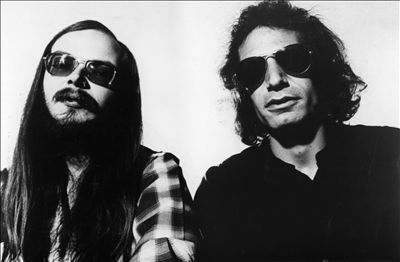
Dan of Steel
Not everything has to be cool. Steely Dan, with all its studio sheen and high brow hyper literacy, its glittery saxophone solos and Weather Channel guitar riffs, is so irremediably uncool it hurts. Your dad loves it. Your uncle loves it. Your grandma doesn’t wince when it comes over the stereo. Gin and tonics. Greek mythology. California sunshine and New York City grit. The 1970s. Steely Dan is everything we tried to throw away but couldn’t.
In Pitchfork’s famous roast of Steely Dan’s comeback record Two Against Nature, critic Brent DiCrescenzo wrote, “If you’re a regular Pitchfork reader … why are you even curious about Steely Dan in 2000?!” It’s an honest question, albeit one tinged with sarcasm and snark.
I will try to answer him by extending the inquiry even further: Why would anyone care about Steely Dan in 2013, when the band is no longer relevant even as a guilty pleasure or musical punching bag? The answer lies in three places: nostalgia, sonic precision and the reversal of the once perennially uncool.
My relationship with Steely Dan began as a child. Whenever I hear the chorus on Aja’s “Josie,” I instantly think of driving home in the wee hours of the morning from New York City with my father — the endless row of highway lights, the way the city slowly and languidly transitioned into suburban Long Island as we passed through Queens. I recall, on one of these drives, him trying to explain to me the multifaceted meaning of the word “bad,” and how in the context of this song — “When Josie comes home / So bad / She’s the best friend we ever had” — Josie’s love of mischief is chic. I can’t hear the song now without my mind darting back to that night.
As a studio band, Steely Dan was precise in a unique, unparalleled way. While Brian Wilson’s Pet Sounds production ebbed and flowed with loving imprecision, Donald Fagen and Walter Becker of Steely Dan crafted their records like pedantic drill sergeants. Nothing was out of place, lending albums such as Aja or Katy Lied a sense of dryness and sterility many people found off-putting, its compositions too stuffy and clean to be called rock music but not freewheeling and nomadic enough to be considered jazz.
However, we can actually call Steely Dan a pop group for these sensibilities. Pop music is conducive to exactness. What you hear on the radio is, a la Aja or Katy Lied, stuffy and clean. Steely Dan was exact, but in a knotty, revolutionary way many are too jaded to appreciate, leading to the final reason you should care about the band in 2013: Steely Dan is now as radical as it has ever been.
In writing his review of Two Against Nature, DiCrescenzo skewers Steely Dan by making an overarching generalization about what young people care about. He writes, “At work you’re too embarrassed to ask the young tech guys how the ‘web’ works. They’d snicker before cranking The Fragile back up and turning back to their monitors.” Maybe this was true in 2000, when the “web” was still an anomaly, but today, it is as naturalized as pop music. History exists in condensed form on the Internet. The lines between cool and uncool are forever blurred.
Now more than ever is the best time to listen to Steely Dan, when there is no real measuring stick for chicness. Not everything has to be cool. Nothing is cool.



